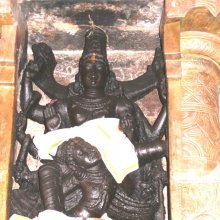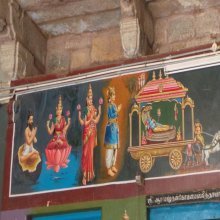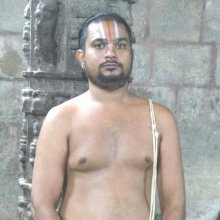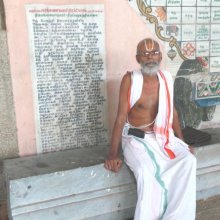Shankhacakra, Śaṅkhacakra, Shankha-cakra: 3 definitions
Introduction:
Shankhacakra means something in Hinduism, Sanskrit. If you want to know the exact meaning, history, etymology or English translation of this term then check out the descriptions on this page. Add your comment or reference to a book if you want to contribute to this summary article.
The Sanskrit term Śaṅkhacakra can be transliterated into English as Sankhacakra or Shankhacakra, using the IAST transliteration scheme (?).
Alternative spellings of this word include Shankhachakra.
Images (photo gallery)
In Hinduism
Shaktism (Shakta philosophy)
Source: Brill: Śaivism and the Tantric Traditions (shaktism)Śaṅkhacakra (शङ्खचक्र) refers to “(being marked by the) conch and discus”`, according to the King Vatsarāja’s Pūjāstuti called the Kāmasiddhistuti (also Vāmakeśvarīstuti), guiding one through the worship of the Goddess Nityā.—Accordingly, “[...] I honour Padmā, [beautiful and tender like] a lotus plant. Her eyes are lotus-like and she dwells in a bed of lotuses. Her four arms look splendid with two lotuses [in two hands] and the gestures of grace and safety [in two others]. May the virgin goddess Durgā annihilate my hardships, I pray. Her hands are marked by the conch and discus (śaṅkhacakra). She has curly locks and rides [a lion,] the king of wild animals. [...]

Shakta (शाक्त, śākta) or Shaktism (śāktism) represents a tradition of Hinduism where the Goddess (Devi) is revered and worshipped. Shakta literature includes a range of scriptures, including various Agamas and Tantras, although its roots may be traced back to the Vedas.
Languages of India and abroad
Sanskrit dictionary
Source: Cologne Digital Sanskrit Dictionaries: Monier-Williams Sanskrit-English DictionaryŚaṅkhacakra (शङ्खचक्र):—[=śaṅkha-cakra] [from śaṅkha] ([in the beginning of a compound]) a conch and a discus
Sanskrit, also spelled संस्कृतम् (saṃskṛtam), is an ancient language of India commonly seen as the grandmother of the Indo-European language family (even English!). Closely allied with Prakrit and Pali, Sanskrit is more exhaustive in both grammar and terms and has the most extensive collection of literature in the world, greatly surpassing its sister-languages Greek and Latin.
Nepali dictionary
Source: unoes: Nepali-English DictionaryŚaṅkha-cakra (शङ्ख-चक्र):—n. (lit conch and discus) 1. the markings and lines on the skin of the fingers; 2. Mythol. the musical instrument or weapon of Vishnu;
Nepali is the primary language of the Nepalese people counting almost 20 million native speakers. The country of Nepal is situated in the Himalaya mountain range to the north of India.
See also (Relevant definitions)
Partial matches: Shankha, Cakra.
Starts with: Shankhacakradharanavada, Shankhacakradharanavidhi, Shankhacakragadadhara, Shankhacakrankanaprayashcitta, Shankhacakrapani, Shankhacakravidhi, Shankhacakravivarana.
Query error!
Full-text (+7): Shankhacakravivarana, Shankhacakravidhi, Shankhacakrapani, Shankhacakragadadhara, Shankhacakradharanavada, Dvadashamurti, Shankh-chakra, Shrimudra, Trivikrama, Shridhara, Kesava, Nirmalai, Krodhana, Samyutta-hastani, Agniprakaramantra, Mudradhyaya, Padma, Pujasadhanalakshana, Lilavati, Gada.
Relevant text
Search found 27 books and stories containing Shankhacakra, Śaṅkha-cakra, Sankha-cakra, Śaṅkhacakra, Sankhacakra, Shankha-cakra; (plurals include: Shankhacakras, cakras, Śaṅkhacakras, Sankhacakras). You can also click to the full overview containing English textual excerpts. Below are direct links for the most relevant articles:
Brihad Bhagavatamrita (commentary) (by Śrī Śrīmad Bhaktivedānta Nārāyana Gosvāmī Mahārāja)
Verse 2.1.73 < [Chapter 1 - Vairāgya (renunciation)]
Garga Samhita (English) (by Danavir Goswami)
Verse 8.13.44 < [Chapter 13 - A Thousand Names of Lord Balarāma]
Chaitanya Bhagavata (by Bhumipati Dāsa)
Verse 2.13.196 < [Chapter 13 - The Deliverance of Jagāi and Mādhāi]
Verse 2.24.49 < [Chapter 24 - The Lord Displays His Universal Form to Advaita]
Verse 2.8.65 < [Chapter 8 - The Manifestation of Opulences]
Notices of Sanskrit Manuscripts (by Rajendralala Mitra)
Page 18 < [Volume 5 (1879)]
Isanasivagurudeva Paddhati (study) (by J. P. Prajith)
4. Concept of Visnu in Isanasivagurudeva-paddhati < [Chapter 3 - Depiction of Gods and Goddesses]
5. The treatment of Shakti concept in Isanasivagurudeva-paddhati < [Chapter 3 - Depiction of Gods and Goddesses]
3. The Supremacy of Lord Siva in Isanasivagurudeva-paddhati < [Chapter 3 - Depiction of Gods and Goddesses]
Skanda Purana (by G. V. Tagare)
Chapter 61 - The Greatness of Vaiṣṇava Tīrthas < [Section 2 - Uttarārdha]




